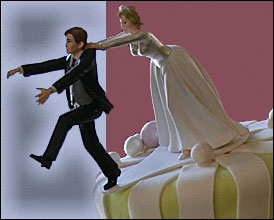Further Beyond the ‘M’ Word: A Response to Arlene Skolnick
Further Beyond the ‘M’ Word: A Response to Arlene Skolnick
A response to Arlene Skolnick’s article, Beyond the ‘M’ Word: The Tangled Web of Politics and Marriage in the Fall 2006 issue.
I have long admired Arlene Skolnick’s writing on the family, but both my empirical study of long-term single women and my reading of the demographic data lead me to reject her view in “Beyond the ‘M’ Word” (Dissent, Fall 2006).  Skolnick argues that the United States is experiencing just a period of flux in the indestructible institution of marriage. She believes that the high divorce rate, decreasing remarriage rates, rise in out-of-wedlock births, increasing cohabitation, and the rising age of marriage reflect merely difficulties in moving from a male breadwinner marriage system to one of a union of working and intimate equals—a transition that, she says, may take another generation or so. During this period and beyond, Skolnick asserts, marriage will “remain central to American culture.”
Skolnick argues that the United States is experiencing just a period of flux in the indestructible institution of marriage. She believes that the high divorce rate, decreasing remarriage rates, rise in out-of-wedlock births, increasing cohabitation, and the rising age of marriage reflect merely difficulties in moving from a male breadwinner marriage system to one of a union of working and intimate equals—a transition that, she says, may take another generation or so. During this period and beyond, Skolnick asserts, marriage will “remain central to American culture.”
Accepting Skolnick’s analysis would mean that the left could continue to put the issues of family change on the back burner. In contrast, the right wing in the United States takes seriously the decline of marriage and family. I agree with Skolnick’s rejection of the conservative analysis that changes in marriage and family life in the last third of the twentieth century represent “moral decay.” I agree with her strong critique of the right’s nostalgia for an imaginary family of the past, one free of tensions and conflicts. If the left, however, does not take seriously that irreversible changes in marriage and family life are occurring, we leave a gap for fundamentalists to fill.
Progressives need to consider an alternative perspective: marriage will not die, but it will no longer play the central institutional role that it has in the past. Nor can our shrinking families supply the material support and caregiving that large, extended families once provided.
The Decline of Marriage
The U.S. Census Bureau’s reports on household and living arrangements provide the best overview of how people actually live. Its studies provide a snapshot of only one point in time, but looking at how the picture has changed between 1970 and 2005, we can see significant alterations. Despite all the publicity about the rise of cohabitation and of single parents, in 2005, only 5.4 percent of all households had cohabitating couples, both heterosexual and same sex, and 9.8 percent of households consisted of single parents. The radical changes are the decline in married couple households (from 70.6 percent of all households in 1970 to 49.7 percent in 2005) and the rise in people living alone (17 percent of households in 1970 compared to 27 percent of households in 2005). These figures are more extreme in large cities, topped by New York City, where 48 percent of households consist of a single person.
Never before in U.S. history has the number of households ...
Subscribe now to read the full article
Online OnlyFor just $19.95 a year, get access to new issues and decades' worth of archives on our site.
|
Print + OnlineFor $35 a year, get new issues delivered to your door and access to our full online archives.
|






